An Analysis of the Challenges of Living Under the Sea: A Study
VerifiedAdded on 2023/04/23
|6
|1319
|316
Essay
AI Summary
This essay delves into the multifaceted challenges of living under the sea, drawing upon various aspects of oceanography including chemical, biological, geological, and meteorological factors. It highlights the historical context, from the limitations faced by early divers to the advancements that have enabled extended underwater stays. The essay examines the physical principles at play, such as Boyle's, Gay-Lussac's, Henry's, Dalton's, and Charles's laws, and their implications for scuba diving and the human body. It explores the hazards associated with deep-sea diving, including decompression sickness, the effects of pressure on breathing, and the physiological impacts of various gases. The essay also addresses practical obstacles like strong currents, visibility, and marine life risks. Finally, it discusses research findings and the potential for future underwater exploration and habitation.
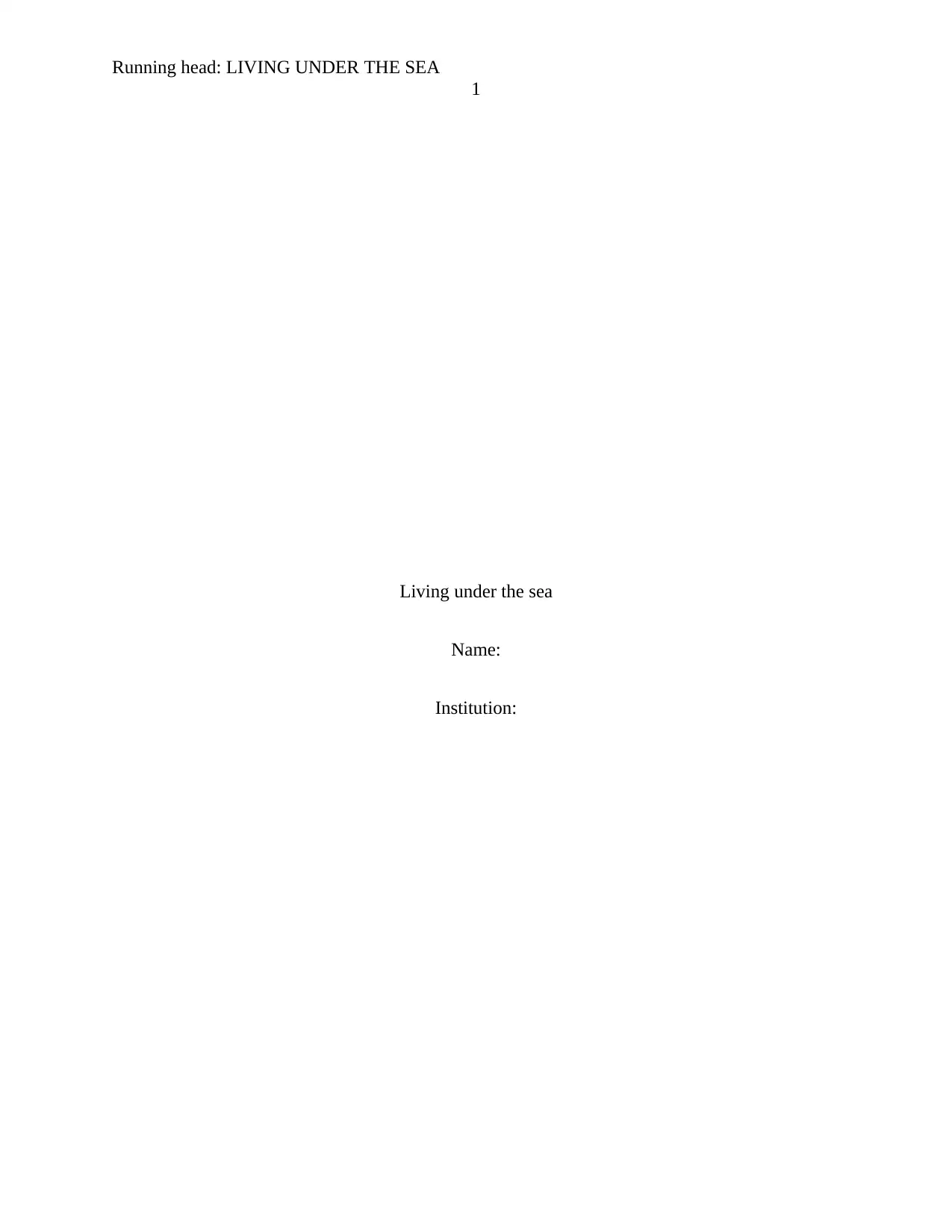
Running head: LIVING UNDER THE SEA
1
Living under the sea
Name:
Institution:
1
Living under the sea
Name:
Institution:
Paraphrase This Document
Need a fresh take? Get an instant paraphrase of this document with our AI Paraphraser
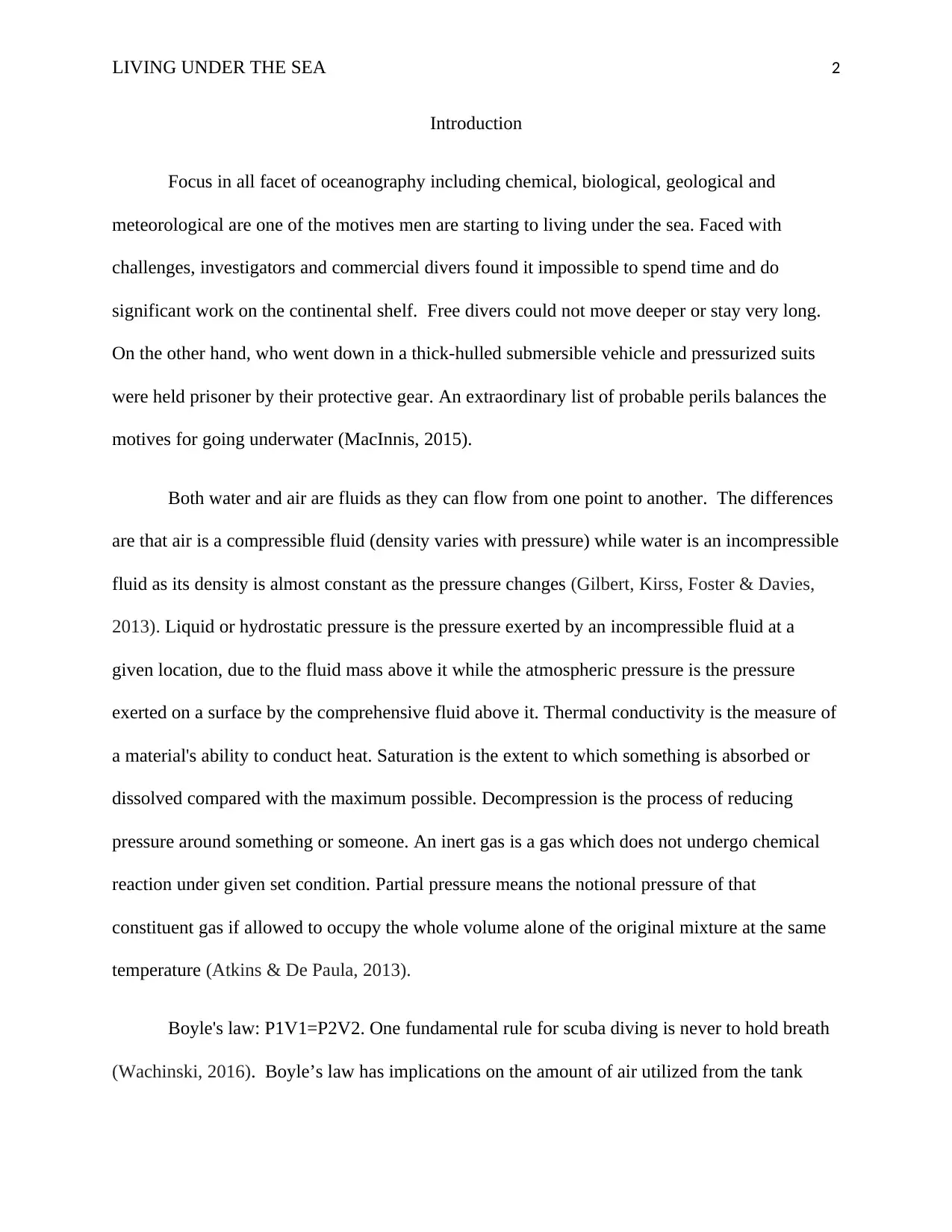
LIVING UNDER THE SEA 2
Introduction
Focus in all facet of oceanography including chemical, biological, geological and
meteorological are one of the motives men are starting to living under the sea. Faced with
challenges, investigators and commercial divers found it impossible to spend time and do
significant work on the continental shelf. Free divers could not move deeper or stay very long.
On the other hand, who went down in a thick-hulled submersible vehicle and pressurized suits
were held prisoner by their protective gear. An extraordinary list of probable perils balances the
motives for going underwater (MacInnis, 2015).
Both water and air are fluids as they can flow from one point to another. The differences
are that air is a compressible fluid (density varies with pressure) while water is an incompressible
fluid as its density is almost constant as the pressure changes (Gilbert, Kirss, Foster & Davies,
2013). Liquid or hydrostatic pressure is the pressure exerted by an incompressible fluid at a
given location, due to the fluid mass above it while the atmospheric pressure is the pressure
exerted on a surface by the comprehensive fluid above it. Thermal conductivity is the measure of
a material's ability to conduct heat. Saturation is the extent to which something is absorbed or
dissolved compared with the maximum possible. Decompression is the process of reducing
pressure around something or someone. An inert gas is a gas which does not undergo chemical
reaction under given set condition. Partial pressure means the notional pressure of that
constituent gas if allowed to occupy the whole volume alone of the original mixture at the same
temperature (Atkins & De Paula, 2013).
Boyle's law: P1V1=P2V2. One fundamental rule for scuba diving is never to hold breath
(Wachinski, 2016). Boyle’s law has implications on the amount of air utilized from the tank
Introduction
Focus in all facet of oceanography including chemical, biological, geological and
meteorological are one of the motives men are starting to living under the sea. Faced with
challenges, investigators and commercial divers found it impossible to spend time and do
significant work on the continental shelf. Free divers could not move deeper or stay very long.
On the other hand, who went down in a thick-hulled submersible vehicle and pressurized suits
were held prisoner by their protective gear. An extraordinary list of probable perils balances the
motives for going underwater (MacInnis, 2015).
Both water and air are fluids as they can flow from one point to another. The differences
are that air is a compressible fluid (density varies with pressure) while water is an incompressible
fluid as its density is almost constant as the pressure changes (Gilbert, Kirss, Foster & Davies,
2013). Liquid or hydrostatic pressure is the pressure exerted by an incompressible fluid at a
given location, due to the fluid mass above it while the atmospheric pressure is the pressure
exerted on a surface by the comprehensive fluid above it. Thermal conductivity is the measure of
a material's ability to conduct heat. Saturation is the extent to which something is absorbed or
dissolved compared with the maximum possible. Decompression is the process of reducing
pressure around something or someone. An inert gas is a gas which does not undergo chemical
reaction under given set condition. Partial pressure means the notional pressure of that
constituent gas if allowed to occupy the whole volume alone of the original mixture at the same
temperature (Atkins & De Paula, 2013).
Boyle's law: P1V1=P2V2. One fundamental rule for scuba diving is never to hold breath
(Wachinski, 2016). Boyle’s law has implications on the amount of air utilized from the tank
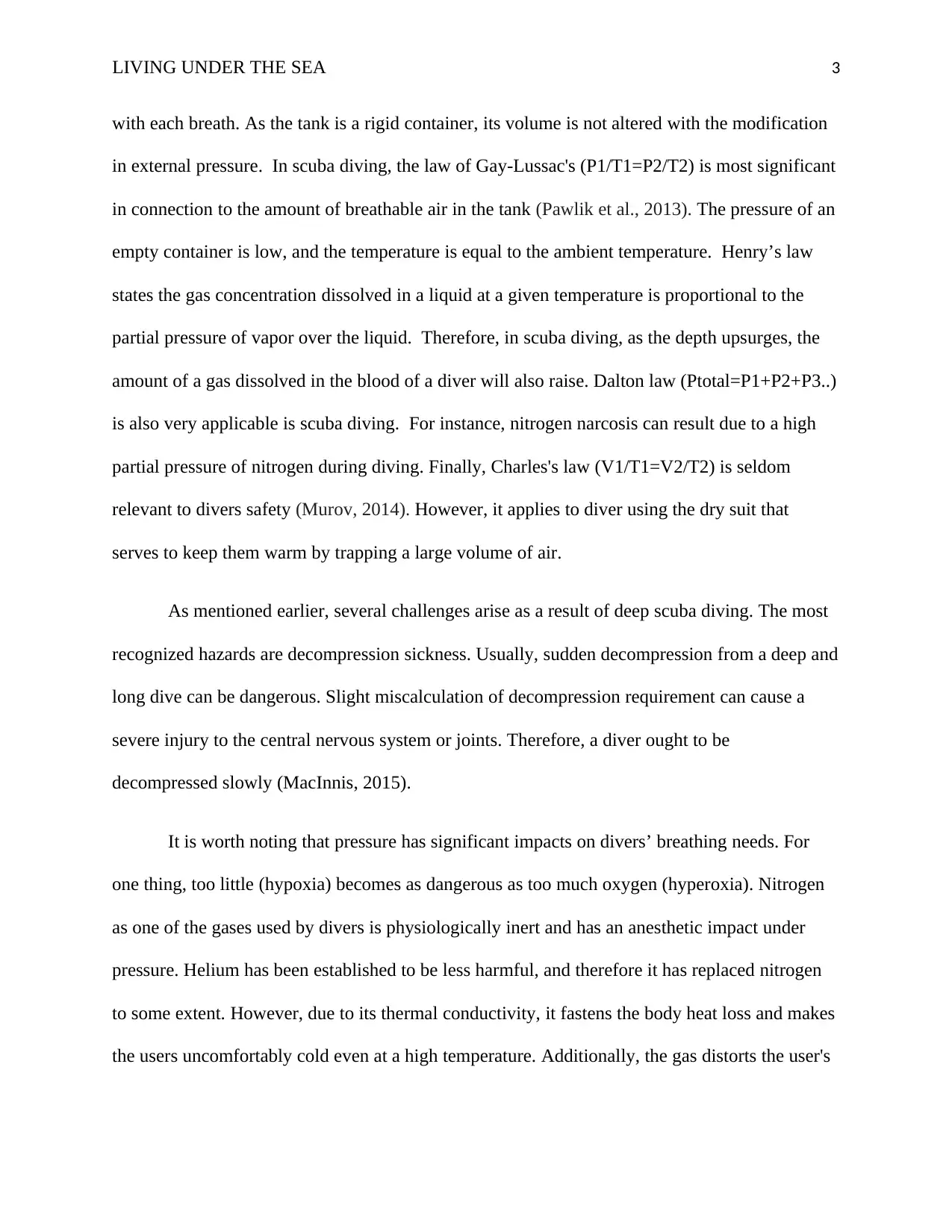
LIVING UNDER THE SEA 3
with each breath. As the tank is a rigid container, its volume is not altered with the modification
in external pressure. In scuba diving, the law of Gay-Lussac's (P1/T1=P2/T2) is most significant
in connection to the amount of breathable air in the tank (Pawlik et al., 2013). The pressure of an
empty container is low, and the temperature is equal to the ambient temperature. Henry’s law
states the gas concentration dissolved in a liquid at a given temperature is proportional to the
partial pressure of vapor over the liquid. Therefore, in scuba diving, as the depth upsurges, the
amount of a gas dissolved in the blood of a diver will also raise. Dalton law (Ptotal=P1+P2+P3..)
is also very applicable is scuba diving. For instance, nitrogen narcosis can result due to a high
partial pressure of nitrogen during diving. Finally, Charles's law (V1/T1=V2/T2) is seldom
relevant to divers safety (Murov, 2014). However, it applies to diver using the dry suit that
serves to keep them warm by trapping a large volume of air.
As mentioned earlier, several challenges arise as a result of deep scuba diving. The most
recognized hazards are decompression sickness. Usually, sudden decompression from a deep and
long dive can be dangerous. Slight miscalculation of decompression requirement can cause a
severe injury to the central nervous system or joints. Therefore, a diver ought to be
decompressed slowly (MacInnis, 2015).
It is worth noting that pressure has significant impacts on divers’ breathing needs. For
one thing, too little (hypoxia) becomes as dangerous as too much oxygen (hyperoxia). Nitrogen
as one of the gases used by divers is physiologically inert and has an anesthetic impact under
pressure. Helium has been established to be less harmful, and therefore it has replaced nitrogen
to some extent. However, due to its thermal conductivity, it fastens the body heat loss and makes
the users uncomfortably cold even at a high temperature. Additionally, the gas distorts the user's
with each breath. As the tank is a rigid container, its volume is not altered with the modification
in external pressure. In scuba diving, the law of Gay-Lussac's (P1/T1=P2/T2) is most significant
in connection to the amount of breathable air in the tank (Pawlik et al., 2013). The pressure of an
empty container is low, and the temperature is equal to the ambient temperature. Henry’s law
states the gas concentration dissolved in a liquid at a given temperature is proportional to the
partial pressure of vapor over the liquid. Therefore, in scuba diving, as the depth upsurges, the
amount of a gas dissolved in the blood of a diver will also raise. Dalton law (Ptotal=P1+P2+P3..)
is also very applicable is scuba diving. For instance, nitrogen narcosis can result due to a high
partial pressure of nitrogen during diving. Finally, Charles's law (V1/T1=V2/T2) is seldom
relevant to divers safety (Murov, 2014). However, it applies to diver using the dry suit that
serves to keep them warm by trapping a large volume of air.
As mentioned earlier, several challenges arise as a result of deep scuba diving. The most
recognized hazards are decompression sickness. Usually, sudden decompression from a deep and
long dive can be dangerous. Slight miscalculation of decompression requirement can cause a
severe injury to the central nervous system or joints. Therefore, a diver ought to be
decompressed slowly (MacInnis, 2015).
It is worth noting that pressure has significant impacts on divers’ breathing needs. For
one thing, too little (hypoxia) becomes as dangerous as too much oxygen (hyperoxia). Nitrogen
as one of the gases used by divers is physiologically inert and has an anesthetic impact under
pressure. Helium has been established to be less harmful, and therefore it has replaced nitrogen
to some extent. However, due to its thermal conductivity, it fastens the body heat loss and makes
the users uncomfortably cold even at a high temperature. Additionally, the gas distorts the user's
⊘ This is a preview!⊘
Do you want full access?
Subscribe today to unlock all pages.

Trusted by 1+ million students worldwide
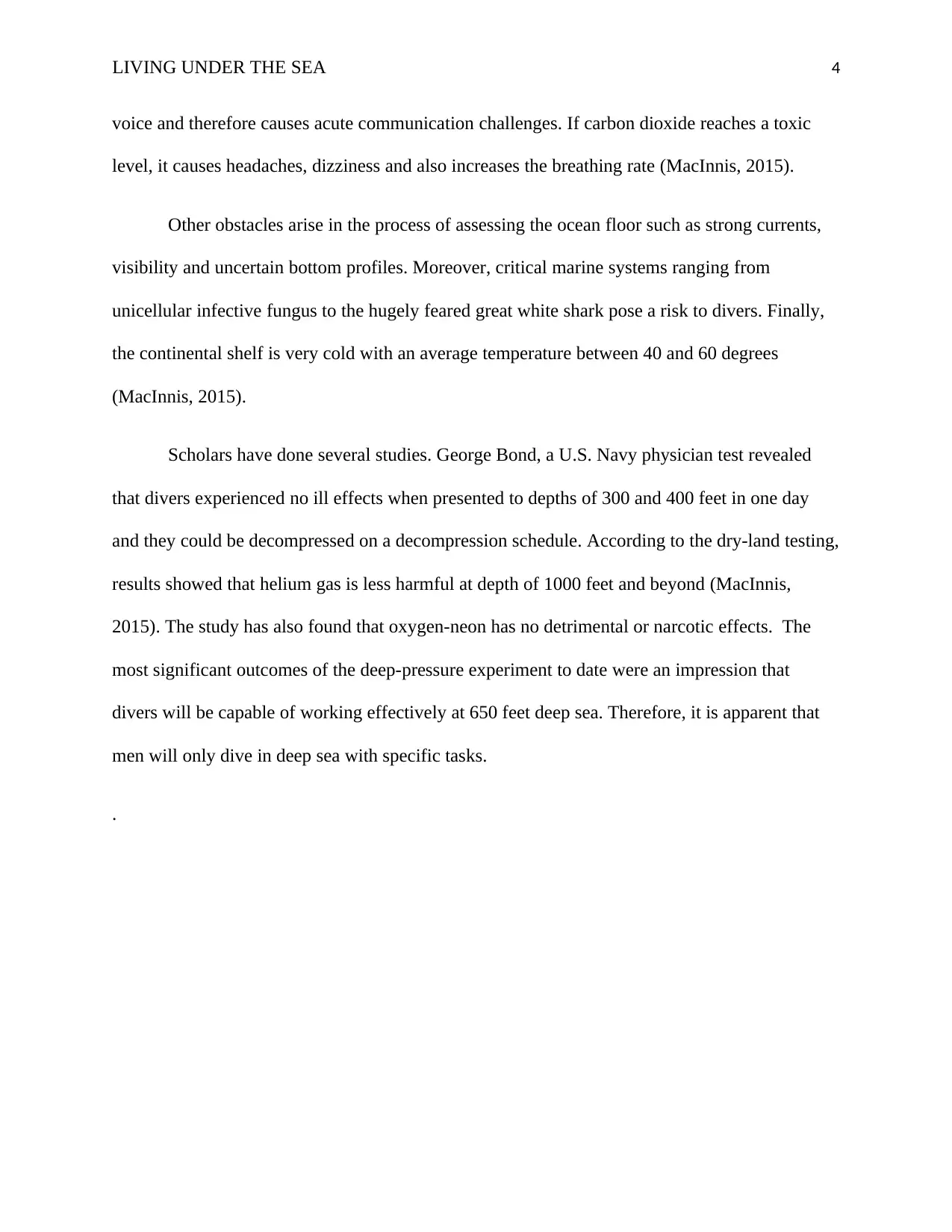
LIVING UNDER THE SEA 4
voice and therefore causes acute communication challenges. If carbon dioxide reaches a toxic
level, it causes headaches, dizziness and also increases the breathing rate (MacInnis, 2015).
Other obstacles arise in the process of assessing the ocean floor such as strong currents,
visibility and uncertain bottom profiles. Moreover, critical marine systems ranging from
unicellular infective fungus to the hugely feared great white shark pose a risk to divers. Finally,
the continental shelf is very cold with an average temperature between 40 and 60 degrees
(MacInnis, 2015).
Scholars have done several studies. George Bond, a U.S. Navy physician test revealed
that divers experienced no ill effects when presented to depths of 300 and 400 feet in one day
and they could be decompressed on a decompression schedule. According to the dry-land testing,
results showed that helium gas is less harmful at depth of 1000 feet and beyond (MacInnis,
2015). The study has also found that oxygen-neon has no detrimental or narcotic effects. The
most significant outcomes of the deep-pressure experiment to date were an impression that
divers will be capable of working effectively at 650 feet deep sea. Therefore, it is apparent that
men will only dive in deep sea with specific tasks.
.
voice and therefore causes acute communication challenges. If carbon dioxide reaches a toxic
level, it causes headaches, dizziness and also increases the breathing rate (MacInnis, 2015).
Other obstacles arise in the process of assessing the ocean floor such as strong currents,
visibility and uncertain bottom profiles. Moreover, critical marine systems ranging from
unicellular infective fungus to the hugely feared great white shark pose a risk to divers. Finally,
the continental shelf is very cold with an average temperature between 40 and 60 degrees
(MacInnis, 2015).
Scholars have done several studies. George Bond, a U.S. Navy physician test revealed
that divers experienced no ill effects when presented to depths of 300 and 400 feet in one day
and they could be decompressed on a decompression schedule. According to the dry-land testing,
results showed that helium gas is less harmful at depth of 1000 feet and beyond (MacInnis,
2015). The study has also found that oxygen-neon has no detrimental or narcotic effects. The
most significant outcomes of the deep-pressure experiment to date were an impression that
divers will be capable of working effectively at 650 feet deep sea. Therefore, it is apparent that
men will only dive in deep sea with specific tasks.
.
Paraphrase This Document
Need a fresh take? Get an instant paraphrase of this document with our AI Paraphraser
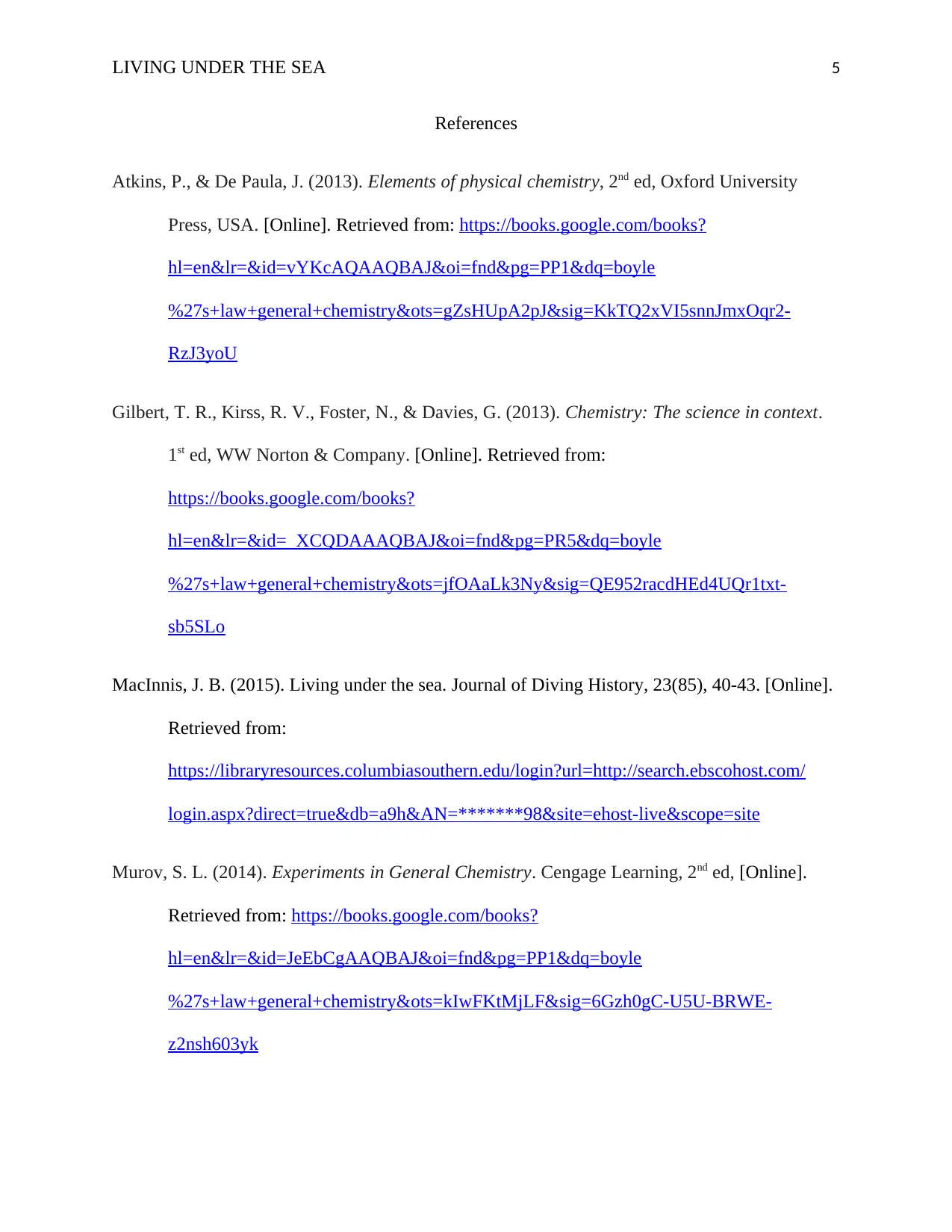
LIVING UNDER THE SEA 5
References
Atkins, P., & De Paula, J. (2013). Elements of physical chemistry, 2nd ed, Oxford University
Press, USA. [Online]. Retrieved from: https://books.google.com/books?
hl=en&lr=&id=vYKcAQAAQBAJ&oi=fnd&pg=PP1&dq=boyle
%27s+law+general+chemistry&ots=gZsHUpA2pJ&sig=KkTQ2xVI5snnJmxOqr2-
RzJ3yoU
Gilbert, T. R., Kirss, R. V., Foster, N., & Davies, G. (2013). Chemistry: The science in context.
1st ed, WW Norton & Company. [Online]. Retrieved from:
https://books.google.com/books?
hl=en&lr=&id=_XCQDAAAQBAJ&oi=fnd&pg=PR5&dq=boyle
%27s+law+general+chemistry&ots=jfOAaLk3Ny&sig=QE952racdHEd4UQr1txt-
sb5SLo
MacInnis, J. B. (2015). Living under the sea. Journal of Diving History, 23(85), 40-43. [Online].
Retrieved from:
https://libraryresources.columbiasouthern.edu/login?url=http://search.ebscohost.com/
login.aspx?direct=true&db=a9h&AN=*******98&site=ehost-live&scope=site
Murov, S. L. (2014). Experiments in General Chemistry. Cengage Learning, 2nd ed, [Online].
Retrieved from: https://books.google.com/books?
hl=en&lr=&id=JeEbCgAAQBAJ&oi=fnd&pg=PP1&dq=boyle
%27s+law+general+chemistry&ots=kIwFKtMjLF&sig=6Gzh0gC-U5U-BRWE-
z2nsh603yk
References
Atkins, P., & De Paula, J. (2013). Elements of physical chemistry, 2nd ed, Oxford University
Press, USA. [Online]. Retrieved from: https://books.google.com/books?
hl=en&lr=&id=vYKcAQAAQBAJ&oi=fnd&pg=PP1&dq=boyle
%27s+law+general+chemistry&ots=gZsHUpA2pJ&sig=KkTQ2xVI5snnJmxOqr2-
RzJ3yoU
Gilbert, T. R., Kirss, R. V., Foster, N., & Davies, G. (2013). Chemistry: The science in context.
1st ed, WW Norton & Company. [Online]. Retrieved from:
https://books.google.com/books?
hl=en&lr=&id=_XCQDAAAQBAJ&oi=fnd&pg=PR5&dq=boyle
%27s+law+general+chemistry&ots=jfOAaLk3Ny&sig=QE952racdHEd4UQr1txt-
sb5SLo
MacInnis, J. B. (2015). Living under the sea. Journal of Diving History, 23(85), 40-43. [Online].
Retrieved from:
https://libraryresources.columbiasouthern.edu/login?url=http://search.ebscohost.com/
login.aspx?direct=true&db=a9h&AN=*******98&site=ehost-live&scope=site
Murov, S. L. (2014). Experiments in General Chemistry. Cengage Learning, 2nd ed, [Online].
Retrieved from: https://books.google.com/books?
hl=en&lr=&id=JeEbCgAAQBAJ&oi=fnd&pg=PP1&dq=boyle
%27s+law+general+chemistry&ots=kIwFKtMjLF&sig=6Gzh0gC-U5U-BRWE-
z2nsh603yk
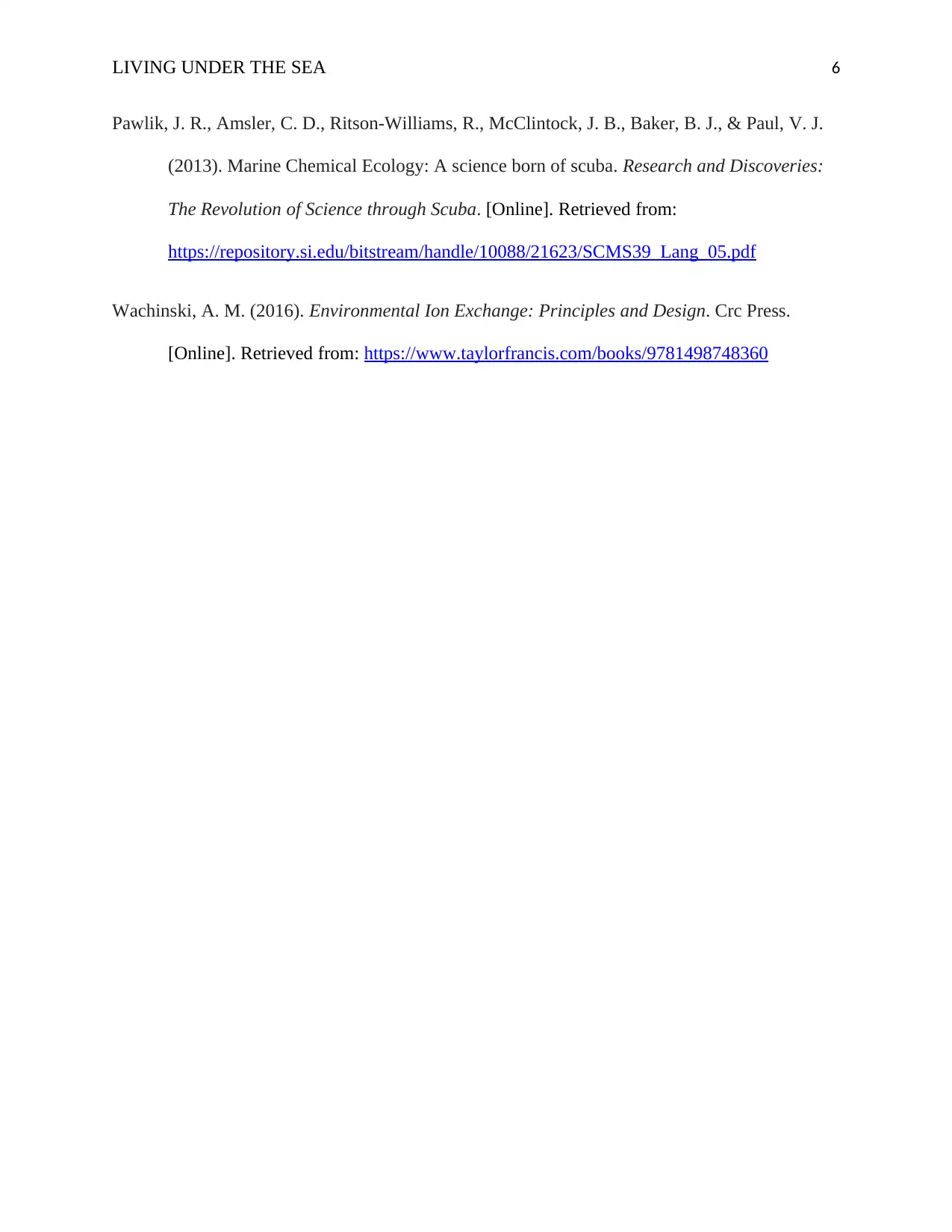
LIVING UNDER THE SEA 6
Pawlik, J. R., Amsler, C. D., Ritson-Williams, R., McClintock, J. B., Baker, B. J., & Paul, V. J.
(2013). Marine Chemical Ecology: A science born of scuba. Research and Discoveries:
The Revolution of Science through Scuba. [Online]. Retrieved from:
https://repository.si.edu/bitstream/handle/10088/21623/SCMS39_Lang_05.pdf
Wachinski, A. M. (2016). Environmental Ion Exchange: Principles and Design. Crc Press.
[Online]. Retrieved from: https://www.taylorfrancis.com/books/9781498748360
Pawlik, J. R., Amsler, C. D., Ritson-Williams, R., McClintock, J. B., Baker, B. J., & Paul, V. J.
(2013). Marine Chemical Ecology: A science born of scuba. Research and Discoveries:
The Revolution of Science through Scuba. [Online]. Retrieved from:
https://repository.si.edu/bitstream/handle/10088/21623/SCMS39_Lang_05.pdf
Wachinski, A. M. (2016). Environmental Ion Exchange: Principles and Design. Crc Press.
[Online]. Retrieved from: https://www.taylorfrancis.com/books/9781498748360
⊘ This is a preview!⊘
Do you want full access?
Subscribe today to unlock all pages.

Trusted by 1+ million students worldwide
1 out of 6
Your All-in-One AI-Powered Toolkit for Academic Success.
+13062052269
info@desklib.com
Available 24*7 on WhatsApp / Email
![[object Object]](/_next/static/media/star-bottom.7253800d.svg)
Unlock your academic potential
Copyright © 2020–2025 A2Z Services. All Rights Reserved. Developed and managed by ZUCOL.